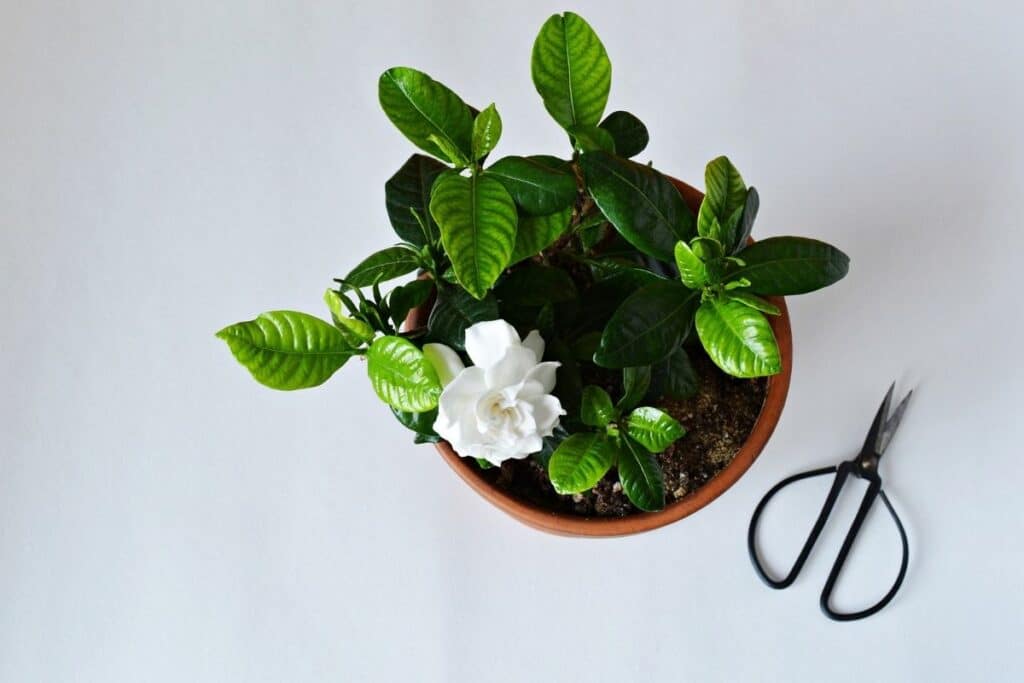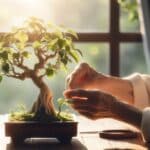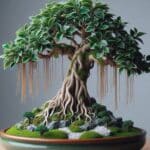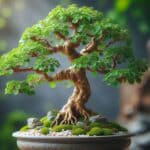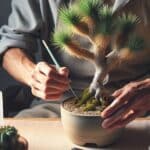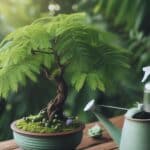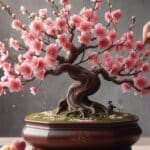A subtropical evergreen shrub, the gardenia is a beautiful plant that is also known as cape jasmine. Native to the tropical regions of South Africa and Asia, it’s a popular houseplant for many people.
Growing gardenia as a bonsai tree is a wonderful choice if you’re looking for a bonsai plant that has lovely white flowers, glossy green leaves, and orange fruits (when pollinated).
A dwarf variety of Gardenia jasminoides produces fragrant white flowers and dark green leaves that contain some toxins – make sure your pets can’t get to it!
Although gardenia bonsai plants don’t like to be moved to new locations and disturbing them too much can cause their buds to fall off, there are plenty of wonderful reasons to consider growing these beauties in your bonsai collection.
Interesting Facts about Gardenia Bonsai
| Height | 8-12” |
| Width | 6-10” |
| Sunlight | Full, indirect sunlight |
| Flowering Time Length | Spring |
| Lifespan | 50 years |
| Scientific Name | Gardenia jasminoides |
Growing Gardenia Bonsai from Seed or by Propagation
Bonsai gardenias are easy to propagate from cuttings. While most bonsai gardeners do this by rooting the cuttings in soil, you can even root them in a glass of water – that’s how easy it is to do this!
To do this, just cut off a small six-inch piece of stem from a healthy plant. Dip it in a bit of rooting hormone. Place it in a jar of water and you’ll see roots in a matter of days. Once there are roots, you can repot it in rich soil designed for acid-loving plants.
How to Care for Gardenia Bonsai Tree
Here are some caring tips you can follow:
Sunlight
Place your bonsai gardenia in a place where it will receive lots of warm air and good air circulation. It should be well lit but make sure you do not place your gardenia bonsai in direct sunlight, keeping it in indirect rays to avoid leaf scorch. Temperatures should be between 60 and 75 degrees Fahrenheit at all times, again, with good ventilation and not too many drafts.
Watering
An acid-loving plant, gardenias are best watered with rainwater which is naturally a bit acidic. However, if you are growing your gardenia bonsai indoors, you can easily get the same effect by avoiding overwatering and using a fertilizer specifically for this purpose. Gardenia bonsai trees like high humidity and can be spritzed often to keep their leaves supple and moist.
Fertilizing
Use a fertilizer formulated specifically for acid-loving plants about twice a month during the main part of the growing season, from the spring until the fall. You can drop down to fertilizing just once per month in the winter.
Potting and Repotting
Repot your gardenia bonsai every other year (or at the very least, every three years) in the spring. Gently prune the roots, removing no more than one-third, and then transplant your gardenia bonsai into a container with soil that is designed for acid-loving plants. This ensures that the entire pot provides the optimal environment for your beautiful bonsai.
Pruning Gardenia Bonsai
Gardenia bonsai needs only to be pruned after it has flowered. You can remove any dead or dried-up flowers if there are no fruits. Additionally, consider root pruning during the early spring, which is the gardenia plant’s first period of growth. This is when the gardenia will be most flexible and amenable to being manipulated with these techniques.
Pests and Diseases
There are just a few pests and diseases that are known to affect gardenia bonsai trees. These include scale, mealy bugs, and aphids, all of which are common on houseplants. Placing your gardenia bonsai in a place where it receives good air circulation can help to prevent these pests, as can limited overwatering and overfetilizing.
Sooty mold thrives on the honey dew produced by the insects listed above. It can be treated with a fungicide but in most cases is far easier to prevent than it is to treat after it has set in.
One problem to which gardenia bonsai plants are prone is bud drop. This usually happens right before blooming and can be caused by various factors, typically improper temperatures, insufficient light, or over or underwatering. Additionally, yellowing leaves can precede bud drop, signaling that the plant is under stress and may not bloom as expected.
Where to Buy Gardenia Bonsai
You can purchase gardenia plants for use in bonsai at most nurseries and gardening supply stores. However, you may have more success (and receive healthier plants) if you purchase gardenia plants that are grown specifically for bonsai from a specialty bonsai dealer.
FAQs
Why is my gardenia bonsai dying?
Several factors could contribute to a gardenia bonsai dying, including overwatering, underwatering, inadequate light, temperature extremes, pests, diseases, or root rot. Assess the growing conditions and address any issues promptly to revive the bonsai.
What kind of fertilizer for bonsai Gardenias?
For bonsai gardenias, use a balanced fertilizer formulated for acid-loving plants. Look for a fertilizer with a higher nitrogen content to promote healthy foliage growth and occasional phosphorus and potassium for flowering. Dilute the fertilizer to half or quarter strength and apply every 4-6 weeks during the growing season.
Can you grow a gardenia indoors?
Yes, you can grow a gardenia indoors, including as a bonsai. Provide bright, indirect sunlight, consistent humidity, and well-draining soil to mimic its natural habitat. Ensure proper watering and avoid placing the plant near drafts or heat sources.
What is the size of gardenia bonsai?
The size of a gardenia bonsai can vary depending on the cultivar and training techniques used. Bonsai gardenias can range from miniature varieties, which are just a few inches tall, to larger specimens that may reach 12-24 inches or more in height.
Are coffee grounds good fertilizer for gardenias?
While coffee grounds can add acidity to the soil, they are not the most suitable fertilizer for gardenias. Excessive use of coffee grounds can alter the soil pH and may cause nutrient imbalances or toxicity in the plant. It’s best to use a balanced fertilizer specifically formulated for gardenias to ensure optimal growth and health.
Up next: How to care for gardenia plant
*image by motyahouse.gmail.com/depositphotos

